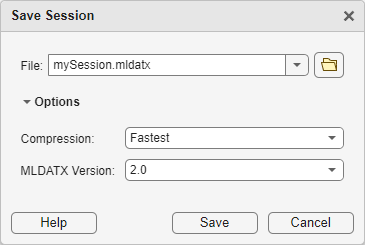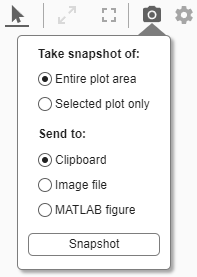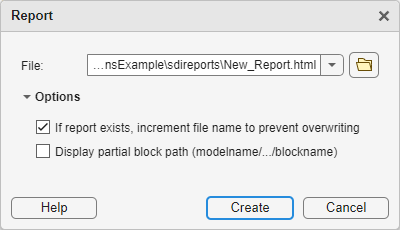保存和共享仿真数据检查器数据和视图
在仿真数据检查器中检查、分析或比较您的数据后,您可以与其他人共享您的结果。仿真数据检查器根据您的需要提供几个共享和保存您的数据和结果的选项。使用仿真数据检查器,您可以:
将您的数据和布局修改保存在仿真数据检查器会话中。
在仿真数据检查器视图中共享您的布局修改。
共享您在仿真数据检查器中创建的绘图的图像和图窗。
创建仿真数据检查器报告。
将数据导出到工作区。
将数据导出到文件。
保存和加载仿真数据检查器会话
要在仿真数据检查器中随配置的视图保存或共享数据,请在仿真数据检查器会话中保存数据和设置。会话保存为 MLDATX 文件。保存仿真数据检查器会话时,会话文件包含:
检查窗格中的所有运行、数据和属性,包括哪个运行是当前运行,哪些运行在存档中
检查窗格中的子图布局、可视化选项和绘制的信号
比较窗格中的当前信号或运行比较
子图自定义,如坐标轴范围、网格线和图例位置
绘制的信号自定义,例如线型和颜色选择
要保存仿真数据检查器会话,请执行以下操作:
点击左边栏上的保存图标
 以打开“保存会话”对话框。
以打开“保存会话”对话框。
在“保存会话”对话框中,您可以命名会话文件,指定 MLDATX 文件版本,并将压缩设置为以下选项之一:
大小和速度的平衡,该选项创建一个在速度最快和文件大小压缩之间达到平衡的文件。
最快,这是默认选项,它创建的文件比未压缩文件小,但保存速度类似。
紧凑,该选项创建的文件大小最小。
无,该选项不压缩文件。此选项创建的文件最大,但保存时间最快。
点击保存或按 Ctrl+S 以保存您的会话文件。对于大型数据集,图形查看区域右下角会叠加显示保存操作的进度状态信息,并允许您取消保存操作。
要使用新文件名保存之前保存的会话,或更改版本或压缩选项,请将鼠标暂停在左边栏上的保存图标  上方。然后,点击另存为。
上方。然后,点击另存为。

注意
在最初保存会话后,点击保存按钮或按 Ctrl+S 会使用默认压缩 Fastest 将会话保存为 MLDATX 版本 2.0 文件。要保持非默认的压缩和版本选项,请点击另存为按钮。
要加载仿真数据检查器会话,请执行以下操作:
点击左边栏上的打开图标
 。
。浏览以选择要打开的 MLDATX 文件。
点击打开。
您也可以双击 MLDATX 文件。MATLAB® 和仿真数据检查器将打开(如果它们尚未打开)。
在 R2024b 之前的版本中: 要加载仿真数据检查器会话文件,请以 MLDATX 1.0 文件格式保存文件。
当仿真数据检查器已包含运行时,加载会话文件将打开“打开会话”对话框。使用“打开会话”对话框,您可以选择:
从仿真数据检查器中删除现有运行,并将会话文件中的数据添加到工作区中。
保留仿真数据检查器中的现有数据,并将会话文件中的数据添加到存档中。
在这两种情况下,视图会更新以显示根据会话文件绘制的信号。您可以根据需要在工作区域和存档之间拖动各次仿真运行。
当仿真数据检查器不包含运行时,如果您打开一个会话,仿真数据检查器会将运行放入工作区域中并按照文件中的指定进行存档。
共享仿真数据检查器视图
当您希望以相同方式可视化不同数据集时,您可以保存视图。视图可以在不保存数据的情况下保存仿真数据检查器的布局和外观特性。具体来说,视图保存:
绘图可视化类型、布局、轴范围、链接特性和归一化坐标区
图中信号的位置
在检查窗格中显示的信号分组和列
信号颜色和线型
要保存视图,请执行以下操作:
点击“可视化和布局”
 。
。在保存的视图中,点击保存当前视图。
在对话框中,指定视图的名称,并浏览到要保存 MLDATX 文件的位置。
点击保存。
要加载视图,请执行以下操作:
点击“可视化和布局”
 。
。在保存的视图中,点击打开保存的视图。
浏览到您要加载的视图,然后点击打开。
共享仿真数据检查器绘图
使用快照功能共享您在仿真数据检查器中生成的绘图。您可以将绘图导出到剪贴板,以作为图像文件粘贴到文档或粘贴到 MATLAB 图窗中。您可以选择捕获整个绘图区域,包括绘图区域中的所有子图,或者仅捕获选定的子图。
点击工具栏上的相机图标  以访问快照菜单。使用单选按钮选择要共享的区域以及共享绘图的方式。作出选择后,点击快照导出绘图。
以访问快照菜单。使用单选按钮选择要共享的区域以及共享绘图的方式。作出选择后,点击快照导出绘图。

如果您创建一个图像,请在文件浏览器中选择要保存图像的位置。
您还可以使用 Simulink.sdi.snapshot 以编程方式在仿真数据检查器中创建绘图的快照。
创建仿真数据检查器报告
要快速生成结果的文档,请创建仿真数据检查器报告。您可以在检查或比较窗格中创建数据的报告。该报告是一个 HTML 文件,其中包含活动窗格中所有信号和绘图的有关信息。该报告包括在导航窗格中的信号表中显示的所有信号信息。有关配置该表的详细信息,请参阅 Inspect Metadata。
要生成仿真数据检查器报告,请执行以下操作:
点击左侧栏上的创建报告图标
 。
。 如果在查看检查窗格时创建报告,该报告将包括来自检查窗格的绘图和信号。

在查看比较窗格时创建报告,该报告包括来自比较窗格的数据和绘图。生成比较报告时,您可以选择仅报告不匹配的信号或报告所有信号。如果选择仅报告不匹配的信号,报告仅显示不在指定容差范围内的信号比较。

在文件文本框中,指定要保存报告的文件名和位置。
在选项下,您可以选择是否防止覆盖文件以及是否在报告中使用缩短的模块路径。
点击创建。
生成的报告会自动在默认浏览器中打开。
将数据导出到工作区或文件
您可以使用仿真数据检查器将数据导出到基础工作区、MAT 文件或 Microsoft® Excel® 文件。您可以导出选定的运行和信号、工作区域中的运行、检查窗格中的所有运行,包括存档。
当您导出选定的运行和信号时,请先选择要导出的数据,再点击导出按钮  。
。
仅导出选定的运行和信号。在本示例中,仅导出 Run 1 和 Run 2 的 x1 信号。绘图数据的复选框选择状态不影响信号是否导出。

当您将单个信号导出到工作区或 MAT 文件时,该信号会导出到 timeseries 对象。导出到工作区或 MAT 文件的一次运行或多个信号的数据存储为 Simulink.SimulationData.Dataset 对象。
要将数据导出为文件,请在“导出”对话框中选择文件。您可以指定文件名并浏览到要保存导出的文件的位置。将数据导出为 MAT 文件时,单个导出的信号的数据存储为 timeseries 对象,运行或多个信号的数据存储为 Simulink.SimulationData.Dataset 对象。在将数据导出为 Microsoft Excel 文件时,数据将使用 Microsoft Excel 导入、导出和记录格式中所述的格式存储。
要导出为 Microsoft Excel 文件,请为文件选择 XLSX 扩展名。在将数据导出为 Microsoft Excel 文件时,可以为导出文件中的数据格式指定其他选项。如果您提供的文件名已存在,您可以选择覆盖整个文件或仅覆盖包含与导出数据对应的数据的工作表。您还可以选择要包括哪些元数据,以及具有相同时间数据的信号是否共享导出文件中的时间列。
将视频信号导出为 MP4 文件
您可以使用仿真数据检查器将包含 RGB 或单色视频数据的二维或三维信号导出到 MP4 文件。例如,当您在仿真中记录视频信号时,可以将数据导出到 MP4 文件,并使用视频播放器查看视频。要将视频信号导出到 MP4 文件,请执行下列步骤:
选择要导出的信号。
点击工具栏中左侧的“导出”
 ,或右键点击信号并选择导出。
,或右键点击信号并选择导出。在“导出”对话框中,对于导出,选择所选运行和信号。对于到,请选择文件。
指定文件名和要保存该文件的位置的路径。
从列表中选择 MP4 视频文件,然后点击导出。
要使用导出到 MP4 文件的选项,需满足以下条件:
一次只能导出一个信号。
所选信号必须为二维或三维信号,并包含 RGB 或单色视频数据。
所选信号必须在仿真数据检查器中表示为具有多维采样值的单个信号。
在导出信号数据之前,您可能需要转换信号表示。有关详细信息,请参阅Analyze Multidimensional Signal Data。
信号值的数据类型必须为
double、single或uint8。
不支持在 Linux® 操作系统上将视频信号导出到 MP4 文件。